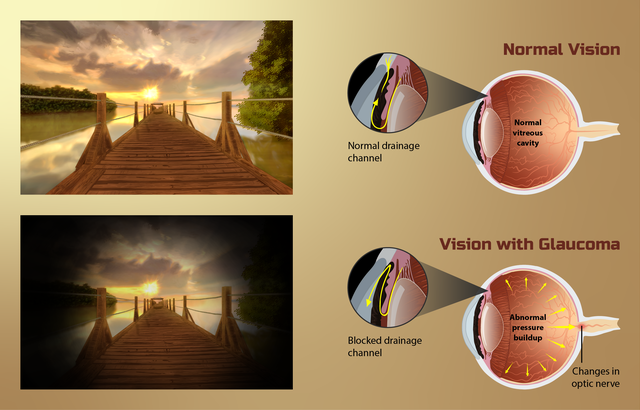A glaucoma is a group of eye diseases that results in loss of optic nerve and vision. There is usually open-angle glaucoma which usually includes closed-angle glaucoma and normal-tension glaucoma. Open-angle glaucoma develops slowly over time and is not painful. Side effects may begin to diminish and then central vision results in blindness if left untreated. Closed-angle glaucoma may present slowly or suddenly. Sudden offerings may include severe eye pain, blurred vision, moderately dilated pupils, redness of the eyes, and nausea. The loss of vision from glaucoma, once it occurs, is permanent
Risk factors for glaucoma include increased eye pressure,
family history of the condition, migraine, hypertension, and obesity. For eye
pressure, values above 21, 21 mm Hg, or 2.8 kPa are often used with high
pressure, which causes more risk. However, eye pressure can be high for a few
years and never hurts. In contrast, optic nerve damage can occur with normal
pressure, which is called normal stress glaucoma. The mechanism of open-angle
glaucoma is thought to be the slow release of aqueous humor through the
trabecular meshwork, while closed-angle glaucoma prevents iris trabecular
meshwork. This diagnosis is made by a dilapidated eye examination. Often the
optic nerve shows an abnormal amount of cupping.
With early treatment, medication,
laser treatment or surgery can slow or stop the progression of the disease. The
purpose of these treatments is to reduce eye strain. There are several classes
of glaucoma medications available. Laser treatments can be effective in both
open-angle and closed-angle glaucoma. Many types of glaucoma surgery can be
used in people who do not respond well to other procedures. In case of closed-angle glaucoma, its treatment will
be a medical emergency.
Globally, about 11 to 67 million
people have glaucoma. The disease affects about 2 million people in the United
States. It is more common in people. Closed-angle glaucoma is more common in
women. Glaucoma is seen as a "silent thief" because vision loss usually
occurs slowly over a long period of time. Worldwide, glaucoma is the second
leading cause of blindness after cataracts. The word "glaucoma" comes
from the ancient Greek word glucose, which means blue, green, or gray. In
English, the word was used as early as 1587 but was not commonly used until
after 1850, when the development of blindness caused people to see damage to
the optic nerve.
Symptoms:
Glaucoma generally does not cause any
symptoms. Usually, glaucoma’s symptoms are much lighter to show. They develop
slowly over years and affect the vision first. Because of this, many people do
not realize they have glaucoma, and this is often elevated during routine eye tests.
Symptoms might be blurred eyes and rainbow circles in bright light.
Sign and Symptoms might be:
·
Redness in eyes
·
Blurred vision
·
Headache
·
Intense eye pain
·
Vomiting and nausea
·
Tenderness around eyes
·
When in lightening, vision problems may occur
Open-angle glaucoma does not have any
acute attacks and it is painless. The most risk factor of glaucoma is ocular hypertension.
But 50% of peoples affected by primary-angle glaucoma have elevated eye pressure.
Surgery of Glaucoma
If glaucoma does not cure with
medications, or the patient didn’t tolerate it the last option left is surgical
intervention. Surgery is done to bring down the pressure in the eye.
Trabeculoplasty:
A laser beam is used
to unlock clogged ducts, making it easier for fluid to drain out of the eye.
Drainage implant:
To drain out fluids
better, a small silicone tube inserted into the eye to help. Used mostly for children
and persons those are who have secondary glaucoma.
Filtering
surgery (Viscocanalostomy)
If
nothing else, including laser surgery, can be performed. Channels are opened
inside the eye to improve drainage.
Prevention:
There is
no known way to prevent glaucoma, but catching it early means it can be treated
more effectively and vision loss can be reduced. Because, often, there are no
symptoms, it is important to check your eyes regularly. Especially for
high-risk people.
Therefore,
older adults, people of African or Hispanic descent, and people with diabetes
should experience this every year or 2 years after the age of 35. Ask your
doctor how often you should have a check-up.

This appears undeniably remarkable. All of these very small facts are constructed choosing large selection about qualifying measures know-how. Document gift a good deal quite a lot. Nausea
ReplyDelete